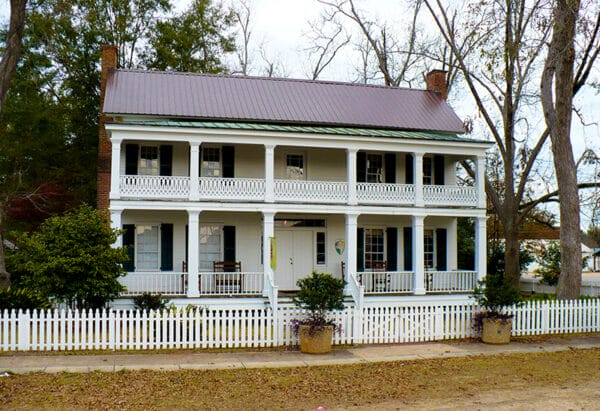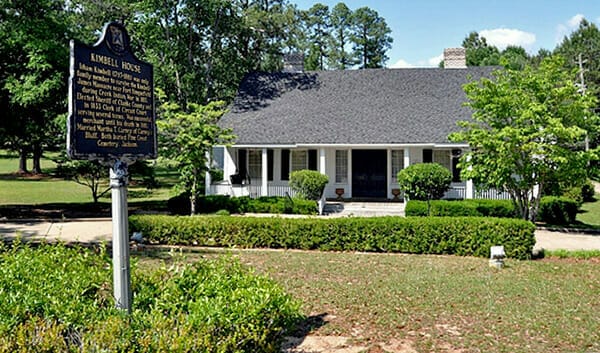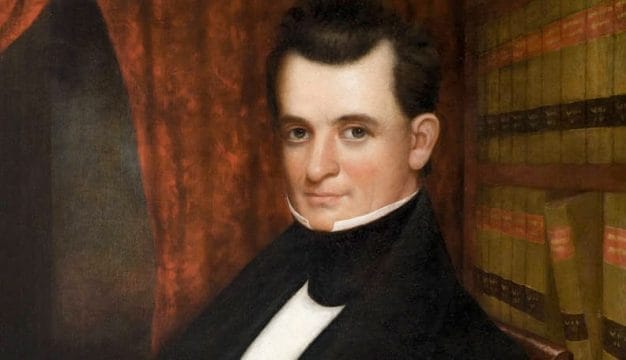Clarke County Historical Museum
The Clarke County Historical Museum is a local history museum complex located on the grounds of the historic Alston-Cobb House in Grove Hill. The home and other structures are owned and operated by the Clarke County Historical Society. The property was listed on the National Register of Historic Places in 1999.
 Clarke County Historical Museum
The Alston-Cobb House is a Greek Revival I-house, or plantation plain home, located near the center of Grove Hill. Lemuel Lovett Alston, a Clarke County doctor, built the house 1854. The two story, five-bay home is constructed of timber framing with clapboard siding and a gabled roof. The first floor has a central hall plan with two rooms on either side, and the upstairs has two rooms. The original double wooden doors were replaced with a single door. The balustrade is made from heart of cypress and is original, as are the two brick chimneys on either end of the house. Modified Doric columns support the double-veranda shed roof.
Clarke County Historical Museum
The Alston-Cobb House is a Greek Revival I-house, or plantation plain home, located near the center of Grove Hill. Lemuel Lovett Alston, a Clarke County doctor, built the house 1854. The two story, five-bay home is constructed of timber framing with clapboard siding and a gabled roof. The first floor has a central hall plan with two rooms on either side, and the upstairs has two rooms. The original double wooden doors were replaced with a single door. The balustrade is made from heart of cypress and is original, as are the two brick chimneys on either end of the house. Modified Doric columns support the double-veranda shed roof.
The museum includes exhibits that interpret many aspects of county and southwest Alabama history. It also boasts a popular exhibit on Basilosaurus cetoides, a prehistoric whale that lived some 35 million years ago in the ocean that covered the area and is the state fossil. Other artifacts and exhibits relate to early white settlers and rural life, Native Americans, the Civil War, World War I, and World War II. There is also a period antebellum kitchen separate from the main house that demonstrates domestic life.
Other historic structures on the museum grounds are the Creagh Law Office, the Turner Corn Crib, and the Mathews Cabin. Judge John Gates Creagh built the law office in 1834 and was an attorney and served as a county commissioner, state legislator, probate judge, and county treasurer. The building was moved from Lot 15 Court Street to Clarke Street in the 1930s and used as a residence. It was then donated by the Gilmore family to honor attorney Wyman Gilmore and moved to its current location on the museum property. It now houses the Grove Hill Area Chamber of Commerce. The Turner Corn Crib was reportedly constructed with logs from the Turner Fort that was used by white settlers during the Creek War. It was donated to the Clarke County Historical Society in 2001. Volunteers disassembled the building, numbered the logs, and reconstructed it on the museum grounds. It exhibits farm tools and other rural life artifacts. Josiah Mathews and his wife Lucy Martin Mathews, who had moved to Clarke County from South Carolina, built the Mathews Cabin in the 1830s. By 1840, 13 family members and two enslaved persons were living in the dogtrot-style cabin. The Clarke County Historical Society purchased the cabin in 2005 and a restoration was begun in the same year. The cabin was moved to its current location on the museum property, where the restoration was completed in 2008. Its reopening ceremony included a descendant of Josiah and Lucy Mathews.
Lemuel Lovett Alston, a Clarke County doctor, built the Alston-Cobb home in 1854 and moved into it with his wife, Sarah French Jackson, that same year. Alston opened up his medical practice in Grove Hill and it is believed that he moved the practice to the home after it was completed. In 1867, Alston moved to Orrville, Dallas County, and sold the home to Alfred Bettis. Bettis, the son of Probate Judge Zachariah Bettis, also was a doctor and practiced out of the home. He moved to northern Clarke County in 1877 and to Texas in 1882. Enoch S. Cobb, who came from a wealthy landowning family that had moved to Clarke County in the 1830s, purchased the home. When the senior Cobb died in 1891, the house went to his youngest son, Jesse, and it remained in the Cobb family until the 1970s. The Clarke County Historical Society purchased the home in 1980 and oversaw its restoration, opening the museum in 1986.
 Kimbell House
A bookstore on site offers titles on a wide range of topics, such as general Alabama history, the Civil War era, and cookbooks and is an outlet for the Historical Quarterly. It is published by the Clarke County Historical Society and has showcased articles related to local history since 1976. The museum frequently hosts school groups and also holds other events, such as monthly historical society meetings, genealogy workshops, speakers, and town hall meetings. It also sponsors living history events, most notably an annual Pioneer Day every October. Re-enactors participating in the event demonstrate blacksmithing, candle making, butter churning, and a number of other period activities.
Kimbell House
A bookstore on site offers titles on a wide range of topics, such as general Alabama history, the Civil War era, and cookbooks and is an outlet for the Historical Quarterly. It is published by the Clarke County Historical Society and has showcased articles related to local history since 1976. The museum frequently hosts school groups and also holds other events, such as monthly historical society meetings, genealogy workshops, speakers, and town hall meetings. It also sponsors living history events, most notably an annual Pioneer Day every October. Re-enactors participating in the event demonstrate blacksmithing, candle making, butter churning, and a number of other period activities.
The museum is located at 116 W. Cobb Street. It is open from 12:00 p.m. to 4:00 p.m. on Mondays, 10:00 a.m. to 4:00 p.m. Tuesdays through Fridays, and Saturday from 10:00 a.m. to 2:00 p.m. Nearby are Fort Sinquefield and the Kimbell House, in Jackson, two sites important in the early part of the Creek War.


